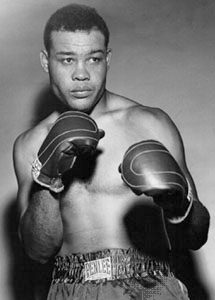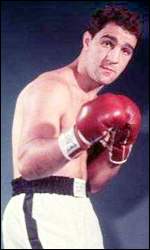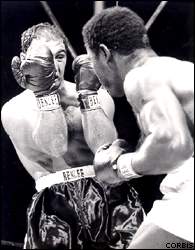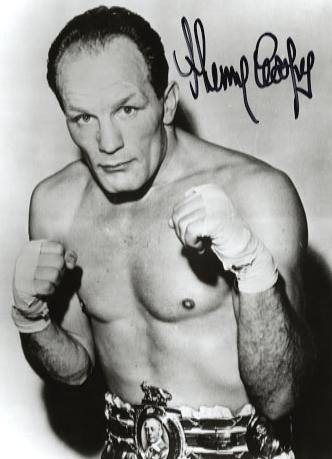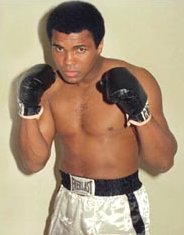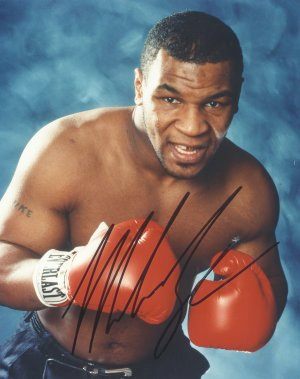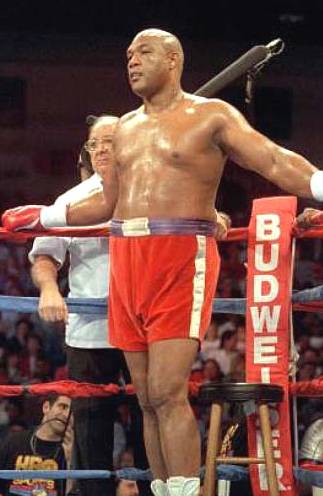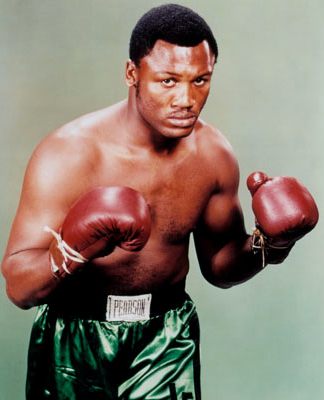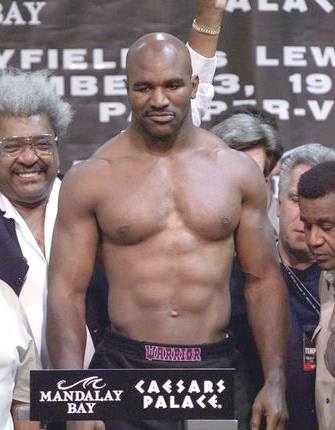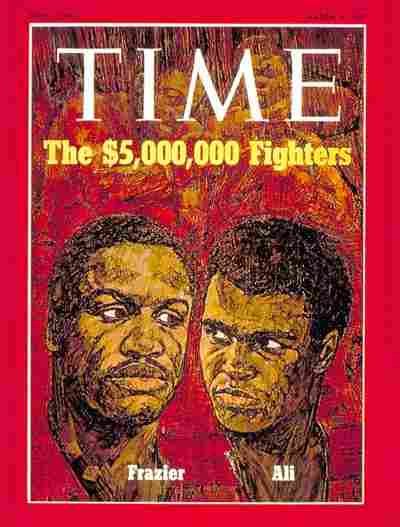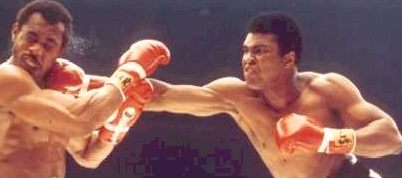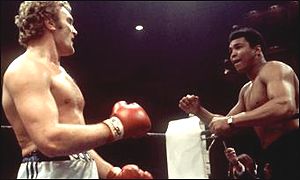|
BOXING
|
||||||||||||||||||
|
Boxing, nicknamed the "sport of kings" and also called pugilism or prizefighting (when referring to professional boxing), is a sport where two participants of similar weight attack each other with their fists in a series of one to three-minute intervals called "rounds". In both Olympic and professional divisions, the combatants (called boxers or fighters) avoid their opponent's punches whilst trying to land punches of their own. Points are awarded for clean, solid blows to the legal area on the front of the opponent's body above the waistline, with hits to the head and torso being especially valuable.
The fighter with the most points after the scheduled number of rounds is declared the winner. Victory may also be achieved if the opponent is knocked down and unable to get up before the referee counts to ten (a Knockout, or KO) or if the opponent is deemed too injured to continue (a Technical Knockout, or TKO). For record keeping a TKO is a knockout or KO. You will see on boxers' records the mention only of "KO". The phrase "technical knockout" usually only appears in contemporaneous news articles.
Joe Louis
Origins
Earliest evidence suggests that boxing was prevalent in North Africa during 4000 BC and the Mediterranean in 1500 BC.
A Greek ruler named Thesus, who ruled around 900 B.C., was entertained by men who would be seated in front of each other and beat another with their fists until one of them was killed. In time, the fighters fought on their feet and wore gloves (not padded) and wrappings on their arms below the elbows, but were otherwise naked when competing. First accepted as an Olympic sport (the ancient Greeks called it Pygme/ Pygmachia) in 688 BC, participants in the ancient games trained on punching bags (called a korykos). Keeping their fingers free, fighters then wore leather straps (called himantes) on their hands, wrists, and sometimes lower arms, to protect them from injury.
In Ancient Rome, fighters were usually criminals and slaves. They hoped to become champions and gain their freedom. However, free men also fought. Eventually, fist fighting became so popular that even aristocrats started fighting, but that was banned by the ruler Augustus. In 500 A.D., the sport was banned by Theodoric the Great.
Rocky Marciano Marciano v Cassius Clay
London Prize Ring rules (1743)
Records of boxing activity disappeared after the fall of the Roman Empire. The sport would later resurface in England during the early 18th century in the form of bare-knuckle prizefighting. The first documented account of a bare-knuckle fight in England appeared in 1681 in the "London Protestant Mercury," and the first English bare-knuckle champion was James Figg in 1719. This is also the time when the word "boxing" first came to be used.
Early bare-knuckle fighting was crude with no written rules. There were no weight divisions, round limits and no referee. Modern rules banning gouging, grappling, biting, headbutting, fish-hooking and blows below the belt were absent.
The first boxing rules, called the London Prize Ring rules, were introduced by heavyweight champion Jack Broughton in 1743 to protect fighters in the ring where deaths sometimes occurred. Under these rules, if a man went down and could not continue after a count of 30 seconds, the fight was over. Hitting a downed fighter and grasping below the waist were prohibited. Broughton also invented "mufflers" (padded gloves), which were used in training and exhibitions.
In 1838, the London Prize Ring rules were expanded in detail. Later revised in 1853, they stipulated the following:
Marquess of Queensberry rules (1867)
In 1867, the Marquess of Queensberry rules were drafted by for Olympic championships held at Lillie Bridge in London for Lightweights, Middleweights and Heavyweights. The rules were published under the patronage of the Marquess of Queensberry, whose name has always been associated with them.
There were twelve rules in all, and they specified that fights should be "a fair stand-up boxing match" in a 24-foot-square ring. Rounds were three minutes long with one minute rest intervals between rounds. Each fighter was given a ten-second count if he was knocked down and wrestling was banned.
The introduction of gloves of "fair-size" also changed the nature of the bouts. An average pair of boxing gloves resembles a bloated pair of mittens and are laced up around the wrists. Gloves protected the hands of both fighters but their considerable size and weight made knock-out victories more difficult to achieve. Resultantly, bouts became longer and more strategic with greater importance attached to defensive maneuvers such as slipping, bobbing, countering and angling.
The English case of R v. Coney in 1882 found that a bare-knuckle fight was an assault occasioning actual bodily harm, despite the consent of the participants. This marked the end of widespread public bare-knuckle contests in England.
The first world heavyweight champion under the Queensberry Rules was "Gentleman Jim" Corbett, who defeated John L. Sullivan in 1892 at the Pelican Athletic Club in New Orleans.
With the gradual acceptance of formalised rules, two distinct branches of boxing emerged; Professional and Olympic. The boxing rules enforced by governing bodies worldwide today at the local, national and international level are all derived in some way from the Marquess of Queensberry Rules.
Henry Cooper
Olympic boxing
Olympic (or Amateur) boxing is found at the Olympic Games and Commonwealth Games. Olympic boxing prizes point scoring rather than physical damage or knockouts. Bouts comprise four rounds of two minutes in Olympic and Commonwealth and three rounds of two minutes in a national ABA (Amateur Boxing association) bout each with a one minute interval between rounds.
Competitors wear protective headgear and gloves with a white strip across the knuckle. A punch is considered a scoring punch only when the boxers connect with the white portion of the gloves. Each punch that lands on the head or torso is awarded a point. A referee monitors the fight to ensure that competitors use only legal blows (a belt worn over the torso represents the lower limit of punches - any boxer repeatedly landing "low blows" is disqualified). Referees also ensure that the boxers don't use holding tactics to prevent the opponent from swinging (if this occurs, the referee separates the opponents and orders them to continue boxing. Repeated holding can result in a boxer being penalized, or ultimately, disqualified).
Referees will stop the bout if a boxer is seriously injured, if one boxer is significantly dominating the other or if the score is severely imbalanced. Olympic (Amateur) boxing history
The Queensberry Amateur Championships continued from 1867 to 1885, and so, unlike their professional counterparts, Olympic boxers did not deviate from using gloves once the Queensberry Rules had been published. In the United Kingdom, the Amateur Boxing Association (A.B.A.) was formed in 1880 when twelve clubs affiliated. It held its first championships the following year. Four weight classes were contested, Featherweight (9 stone), Lightweight (10 stone), Middleweight (11 stone, 4 pounds) and Heavyweight (no limit). (A stone is equal to 14 pounds). By 1902, American boxers were contesting the titles in the A.B.A. Championships, which, therefore, took on an international complexion. By 1924, the A.B.A. had 105 clubs in affiliation.
Boxing first appeared at the Olympic Games in 1904 and, apart from the Games of 1912, has always been part of them. From 1972 through 2004, Cuba and the United States have won the most Gold Medals, 29 for Cuba and 21 for the U.S. Internationally, Olympic boxing spread steadily throughout the first half of the 20th century, but when the first international body, the Federation Internationale de Boxe Olympic (International Olympic Boxing Federation) was formed in Paris in 1920, there were only five member nations. In 1946, however, when the International Amateur Boxing Association (A.I.B.A.) was formed in London, twenty-four nations from five continents were represented, and the A.I.B.A. has continued to be the official world federation of Olympic boxing ever since. The first World Amateur Boxing Championships were staged in 1974.
In the late 19th and early 20th century, Olympic boxing was encouraged in schools, universities and in the armed forces, but the champions usually came from among the urban poor.
Women's boxing first appeared in the Olympic Games at a demonstration bout in 1904. For most of the 20th century, however, it was banned in most nations. Its revival was pioneered by the Swedish Amateur Boxing Association, which sanctioned events for women in 1988. The British Amateur Boxing Association sanctioned its first boxing competition for women in 1997. The first event was to be between two thirteen-year-olds, but one of the boxers withdrew because of hostile media attention. Four weeks later, an event was held between two sixteen-year-olds.
The A.I.B.A. accepted new rules for Women's Boxing at the end of the 20th century and approved the first European Cup for Women in 1999 and the first World Championship for women in 2001. Women's boxing will be an exhibition sport at the 2008 Olympics, but it won't become an official Olympic sport until the 2012 Olympics.
A new scoring system was invented for Olympic boxing: using a computer, judges must press a button every time they think a boxer landed a punch. When three or more of the five judges press the button within a second of each other, the punch counts as a "point" for the fighter that landed it. Punches to the head or face of an opponent usually score the most points for a competitor. At any point of the fight in which a fighter is leading by twenty points (or sometimes more), the referee is indicated and the fight is stopped, the leading fighter winning by "mercy", and credited with a knockout.
Lennox Lewis
Professional boxing
Professional bouts are far longer than Olympic bouts (ranging from four to twelve rounds), headgear is not permitted, and boxers are generally allowed to take much more punishment before a fight is halted. At any time, however, the referee may stop the contest if he believes that one participant can not intelligently defend him or herself due to injury. In that case, the other participant is awarded a technical knockout win, which appears on the boxer's record as a knockout win (or loss). A technical knockout would also be awarded if a fighter lands a punch that opens a cut on the opponent, and the opponent is later deemed not fit to continue by a doctor because of the cut. For this reason, fighters often employ cutmen, whose job is to treat cuts between rounds so that the boxer is able to continue despite the cut. If a boxer simply quits fighting, or if his corner stops the fight, then the winning boxer is also awarded a technical knockout victory.
If a knockout or disqualification does not occur, the fight must go to the scorecards. Professional fights have three judges each, and each of the judges must use the 10 point must system: Under this system, each time a boxer wins a round in the judges' eyes, the judge gives that boxer 10 points, and the other 9 or less. If the judge deems the round to be a tie, he or she may score it 10-10. When the fight reaches its scheduled distance, all scores are added, round by round, to determine who won on each judges' cards. When all three judges have the same boxer as the winner, this is an unanimous decision. When two judges have one boxer winning the fight and the other one has it a tie, this is called a majority decision. When two judges have one boxer winning the fight and the other judge has the other boxer winning, this is called a split decision. When one judge gives his or her vote to one boxer, another one gives it to the other boxer, and the third judge calls it a tie, this is a draw. It is also a draw when two judges score the fight a tie, regardless of who the third judge scored the bout for.
In the United Kingdom, the bout is only scored by the referee, except when a title is at stake, in which case it is scored by three judges. If a fight can not go on because of an injury caused to one of the competitors by a headbutt, there are different rules: If the fight has not reached the end of round three, (in some places, round four), the fight is declared a technical draw or a no contest. If it has reached beyond the end of round three (or four), then the scorecards are read and whoever is ahead, wins by a technical decision.
Evolution of professional boxing
In 1891, the National Sporting Club (N.S.C.), a private club in London, began to promote professional glove fights at its own premises, and created nine of its own rules to augment the Queensberry Rules. These rules specified more accurately the role of the officials, and produced a system of scoring that enabled the referee to decide the result of a fight. The British Boxing Board of Control (B.B.B.C.) was first formed in 1919 with close links to the N.S.C., and was re-formed in 1929 after the N.S.C. closed.
In 1909, the first of twenty-two belts were presented by the fifth Earl of Lonsdale to the winner of a British title fight held at the N.S.C. In 1929, the B.B.B.C. continued to award Lonsdale belts to any British boxer who won three title fights in the same weight division. The "title fight" has always been the focal point in professional boxing. In the 19th and early 20th centuries, however, there were title fights at each weight. Promoters who could stage profitable title fights became influential in the sport, as did boxers' managers. The best promoters and managers have been instrumental in bringing boxing to new audiences and provoking media and public interest. The most famous of all three-way partnership (fighter-manager-promoter) was that of Jack Dempsey (Heavyweight Champion, 1919-1926), his manager Jack Kearns, and the promoter Tex Rickard. Together they grossed US$ 8.4 million in only five fights between 1921 and 1927 and ushered in a "golden age" of popularity for professional boxing in the 1920s. They were also responsible for the first live radio broadcast of a title fight (Dempsey v. Georges Carpentier, in 1921). In the United Kingdom, Jack Solomons' success as a fight promoter helped re-establish professional boxing after the Second World War and made the UK a popular place for title fights in the 1950s and 1960s.
In the first part of the 20th century, the United States became the centre for professional boxing. It was generally accepted that the "world champions" were those listed by the Police Gazette. After 1920, the National Boxing Association (N.B.A.) began to sanction "title fights". Also during that time, Ring Magazine magazine was founded and it listed champions and awarded championship belts. The N.B.A. was renamed in 1962 and became the World Boxing Association (W.B.A.). The following year, a rival body, the World Boxing Council (W.B.C.), was formed. In 1983, another world body, the International Boxing Federation (I.B.F.) was formed. By the end of the 20th century, a boxer had to be recognized by the three separate bodies to be the "Undisputed World Champion". Regional sanctioning bodies such as the North American Boxing Federation, the North American Boxing Council and the United States Boxing Association also awarded championships. Ring Magazine also continued listing the World Champion of each weight division, and its rankings continue being of the most appreciated by fans.
Although women fought professionally in many countries, in the United Kingdom the B.B.B.C. refused to issue licences to women until 1998. By the end of the century, however, they had issued five such licenses. The first sanctioned bout between women was in November 1998 at Streatham in London, between Jane Couch and Simona Lukic.
Length of bouts
For decades, from the 1920s to the 1980s, world championship matches in professional boxing were scheduled for fifteen rounds, but that changed after a November 13, 1982 WBA Lightweight title bout ended with the death of boxer Duk Koo Kim in a fight against Ray Mancini in the 14th round of a nationally televised championship fight on CBS.
Exactly three months after the fatal fight, the World Boxing Council reduced the number of their championship fights to 12 rounds. The World Boxing Association even stripped a fighter of his championship in 1983 because the fight had been a 15-round bout, shortly after the rule was changed to 12 rounds. By 1988, to the displeasure of many boxing purists, all fights had been reduced to a maximum of 12 rounds only, partially for safety, and partially for television, as a 12-round bout could take one hour to broadcast, while a 15-round bout could requre 90 minutes to broadcast.
Equipment
Boxing techniques utilize very forceful strikes with the hand. There are many bones in the hand, and striking surfaces without proper technique can cause serious hand injuries. Today, most trainers do not allow boxers to train and spar without hand/wrist wraps and gloves. Handwraps are used to secure the bones in the hand, and the gloves are used to protect the hands from blunt injury, allowing boxers to throw punches with more force than if they did not utilize them.
Headgear, used in Olympic boxing, protects against cuts, scrapes, and swelling, but does not protect very well against concussions. Headgear does not sufficiently protect the brain from the jarring that occurs when the head is struck with great force. Also, most boxers aim for the chin on opponents, and the chin is usually not padded. Thus, a powerpunch can do a lot of damage to a boxer, and even a jab that connects to the chin can cause damage, regardless of whether or not headgear is being utilized.
Muhammad Ali
Technique Stance and movement
Development
The modern boxing stance is a reflection of the current system of rules employed by professional boxing. It differs in many ways from the typical boxing stances of the 19th and early 20th centuries. It's been stated that Americans adopted a more upright vertical armed guard (as opposed to more horizontally held, knuckles facing the ground guard as seen when looking at early 20th century boxers such as Jack Johnson) due to the Americans' confrontations with the Filipino natives as a result of the Philippines Spanish-American war. When engaged in hand to hand combat, the Filipinos would slash the wrists of the American soldiers, the Americans adapted by changing the guarded stance and thus just one example of a boxing technicality evolving.
The Boxer's Stance
The following stance applies for a right-handed boxer. The boxer stands with the legs shoulder-width apart with the right foot a half-step behind the left foot. The left (lead) fist is held vertically about six inches in front of the face at eye level. The right (rear) fist is held beside the chin and the elbow tucked against the ribcage to protect the body. The chin is tucked into the chest to avoid punches to the jaw which commonly cause knock-outs. Modern boxers can sometimes be seen "tapping" their cheeks or foreheads with their fists in order to remind themselves to keep their hands up (which becomes difficult during long bouts).
Movement
Modern boxers are taught to "push off" with their feet in order to move effectively. Forward motion involves lifting the lead leg and pushing with the rear leg. Rearward motion involves lifting the rear leg and pushing with the lead leg. During lateral motion the leg in the direction of the movement moves first while the opposite leg provides the force needed to move the body.
Punches
There are four basic punches in boxing: the Jab, Cross, Hook and Uppercut. If a boxer is right-handed, his left hand is the lead hand, his right hand is the rear hand and vice versa. The following techniques apply to a right-handed boxer. A right-handed boxer's handedness is commonly described as orthodox. A left-handed boxer is called an unorthodox boxer or a Southpaw. These different punching types can be combined to form 'combos', like a jab and cross combo. Nicknamed the one two combo, it is a really effective combination because the jab blinds the opponent and the cross is powerful enough to knock the opponent out.
Mike Tyson
Defense
In the ring
Boxers generally attempt to land short, fast combinations and then quickly shift position to avoid a possible response by their opponent. Strategically, the ring's centre is a desired position since a boxer is able to conserve movement by forcing the opponent to circle around them. When in the centre, the boxer is also less likely to be knocked backwards against the ropes surrounding the ring and cornered. Less common strategies
The "Rope-a-dope" Strategy
Bolo punch
George Foreman
Boxing styles
There are three generally accepted boxing styles that are used to define fighters. They are the in-fighter, the out-fighter and the brawler. In-fighter
In-fighters are often the most exciting boxers to watch. This style favours closing inside an opponent, overwhelming them with intensity and flurries of hooks and uppercuts. They tend to be agile on their feet which can make them difficult to evade for a slower fighter.
The most notable in-fighter would likely be Joe Frazier.
Out-fighter
Out-fighters are the opposite of the in-fighter. Where the in-fighter tries to close the gap between himself and his opponent, the out-fighter seeks to maintain that gap and fight with faster, longer range punches. Since they rely on the weaker jabs and straights (as opposed to hooks and uppercuts), they tend to win by points decisions rather than by knockout, although some out-fighters have notable knockout records. They attempt to control the fight by using their jab to keep their opponent at range, and using their strong footwork to evade any opponent that closes in. Out-fighters are often regarded as the best boxers for their desire to win a fight by wearing his opponent down and outclassing him by strategy, rather than to simply knock them out.
Notable out-fighters include Muhammed Ali and Larry Holmes.
Brawler
If the out-fighter represents everything classy about boxing, the brawler (also known as the 'slugger', 'hard hitter' or 'one puncher') often stands for everything that's wrong with the sport. Sluggers tend to lack finesse in the ring, but make up for it in raw power, often able to knock almost any opponent out with a single punch. This ability makes them exciting to watch, and their fights unpredictable. Many brawlers tend to lack mobility in the ring and have difficulty pursuing fighters who are fast on their feet. They prefer the harder, slower punches (such as hooks and uppercuts) and tend to ignore combination punching. Their slowness and predictable punching patterns (single punches with obvious leads) often leaves them open for counterpunching.
Famous brawlers include Sonny Liston, George Foreman, Mike Tyson (after his prime) and former featherweight champion Naseem Hamed.
Hybrid boxers
These styles are merely archetypes that many boxers fall into. However, some notable fighters transcend any one category. Mike Tyson, although known primarily as a brawler, was a very intense in-fighter in the first half of his career. He had the strength of a brawler, but the combos, agility and ferocity of an in-fighter, which earned him his devastating reputation. Muhammed Ali, known for his footwork and blindingly fast jab, could mix it up on the inside with fast flurries, using his large frame and fast handspeed for more power. Naseem Hamed was primarily a slugger, favouring single, heavy punches, but his agility and reflexes allowed him to move like an out-fighter.
Scissors, Paper, Rock
There is a commonly accepted theory about the success each of these boxing styles has against the others. This is merely a theory and it has been disproven several times, although it serves as a decent guide. The general rule is similar to the game Scissors Paper Rock - each boxing style has advantages over one, but disadvantages against the other.
Brawlers tend to overcome in-fighters, because the in-fighter likes to be on the inside, where the hard-hitting brawler is most effective. The in-fighters flurries tend to be less effective the than power punches of the slugger, who quickly overwhelms his opponents. Two famous examples of these include George Foreman defeating Joe Frazier and Mike Tyson knocking out Joe's son, Marvis Frazier (in just 20 seconds).
If the in-fighter is a meatbag for the brawler, they tend to succeed against out-fighters. Out-fighters prefer a slower fight, with some distance between themselves and the opponent. The in-fighter tries to close that gap and unleash furious flurries. On the inside, the out-fighter loses a lot of his combat effectiveness, because he cannot throw the hard punches. The in-fighter is generally successful in this case, due to his intensity to advance on his opponent and his good agility which him difficult to evade. An example of this type of fight is the first fight between Ali and Joe Frazier, the Fight of the Century, although their following two bouts defy the theory, with Ali winning both.
The out-fighter tends to be most successful against the brawler, whose slow speed (both hand and foot) and poor technique make them an easy target to hit for the faster out-fighter. The out-fighter's main key is to stay alert, as the brawler only needs to land one good punch to finish the fight. If the out-fighter can avoid those power punches, he can often wear the brawler down with fast jabs, tiring the slugger out. If he is successful enough, he may even apply extra pressure in the later rounds in an attempt to achieve a knockout.
By far, the most famous bout to depict this battle is the Rumble in the Jungle, where Muhammed Ali overwhelmed George Foreman in the eighth round to reclaim his heavyweight title.
Hybrid boxers tend to be the most successful in the ring, because they often have advantages against most opponents. Pre-prison Tyson, able to overwhelm any in-fighter with his tremendous power, was also able to use his in-fighting footspeed to close in on and knock out many out-fighters who tried to stay out of his range, such as Michael Spinks. Muhammed Ali's speed kept him away from hard hitters like Sonny Liston and George Foreman, but his strong punching power allowed him to weather Joe Frazier enough to last, and eventually win two of their three bouts.
Joe Frazier
Famous boxers
London rules and pre-Queensberry era
The bareknuckle era produced legends like John L. Sullivan, the first world heavyweight champion in the sport.
1900s to 1920s
One of the most famous boxers of the early 1900's was Tom Polson, who held the flyweight title from 1911-1913. little is known about him except he shot to fame in a quick time and died in suspicious circumstances in late 1913.
In the post-Queensberry era, the first British/New Zealand fighter to achieve superstar status was Bob Fitzsimmons. He weighed less than 12 stone but won world titles at middleweight (1892), light heavyweight (1903), and heavyweight (1897). He fought his last bout at the age of fifty-two.
Famous British boxers include Harry Mallin (Middleweight), 1920 and 1924), Terry Spinks (Flyweight, 1956), Dick McTaggart (Lightweight, 1956) and Chris Finnegan (Middleweight, 1968).
American boxers in the post-Queensberry era include world heavyweight champions Jim Jeffries (the first Great White Hope) and Jack Johnson (the first black world heavyweight champion).
A Welsh flyweight called Jimmy Wilde won the world Flyweight Championship in 1916 and held it until 1923. He once had a sequence of eighty-eight fights without defeat. Between 1911 and 1923, he won seventy-five of his fights by a knockout. He was described in Wales as the "Mighty Atom" and "the ghost with a hammer in his hand".
1920s to 1940s
Jack Dempsey was a world heavyweight champion and dominated the 20's after defeating Jess Willard. One of the hardest punchers of all-time and as Bert Randoulph Sugar put it "Had a left hook from hell."
Joe Louis defended the title for 12 years before retiring as world champion in 1949. Joe Louis was voted the best puncher of all time by Ring magazine.
Another American boxer, James Braddock (nicknamed Cinderella Man) became the world heavyweight champion by defeating Max Baer against 10 to 1 odds. Braddock defeated Corn Griffin, but was destroyed by Joe Louis in a title bout.
In the 1930s, British boxer Jackie Berg won the light welterweight title. In the 1940s, Freddie Mills won the light heavyweight title. In the 1950s and 1960s, Randy Turpin and Terry Downes won middleweight titles. and in the 1970s, John Conteh and John Stracey won the light heavyweight and welterweight titles respectively. With so many title-awarding bodies in the 1980s and 1990s, the public became unsure about who actually was the champion. Among English flyweights, Jackie Brown won the title in 1932, Peter Kane in 1938 and Terry Allen.
A flyweight from Glasgow, Scotland, Benny Lynch, held the world flyweight title in 1935 and again in 1937. Fellow Scotsmen Jackie Paterson won the title in 1943 and Walter McGowan in 1966. Scottish lightweights Ken Buchanan won the title in 1971 and Jim Watt in 1980.
1940s to 1960s
An American boxer in the 1950s, Rocky Marciano, remains the only undefeated world champion in any division. Another American, Sugar Ray Robinson, held the world welterweight title from 1946 to 1951 and the world middleweight title a record five times from 1951 to 1960. American boxer Archie Moore, held the world light heavyweight title for ten years and scored more knockout victories than any other boxer in history. In Northern Ireland, Rinty Monahan held the flyweight title from 1947 to 1950, and Barry McGuigan won the W.B.A. featherweight title in 1985.
1960s to 1980s
In the 1960s to the 1970s, an American heavyweight boxer named Cassius Clay changed his name to Muhammad Ali upon converting to the Abrahamic religion of Islam and promised to "shock the world." Ali fought Sonny Liston, Joe Frazier, Ken Norton, and George Foreman. Ali was known for his charismatic personality and refusal to enlist in the US Army during the Vietnam War.
After Ali retired, American boxer Sugar Ray Leonard won world titles in five different weight divisions.
Evander Holyfield
1980s to present
Nicknamed "Iron Mike", American heavyweight boxer Mike Tyson became world heavyweight champion at the age of 20 and the first undisputed champion in a decade. Controversy surrounded Tyson's career. He made nearly as many headlines for brawls outside the ring as for his matches, and his brief marriage to actress Robin Givens was fodder for the tabloids. Then in 1989, in the biggest upset in boxing history, challenger James "Buster Douglas, a 42 to 1 underdog, knocked Tyson out in the 10th round of their match in Tokyo. In 1991, he was imprisoned for allegedly raping Miss Black Rhode Island, Desiree Washington in an Indianapolis hotel room. In 1996, Tyson was banned from boxing for a year after biting a chunk from Evander Holyfield's ear during a bout. In August 2003, he filed for bankruptcy. In August 2005, Tyson unofficially retired from boxing.
American Roy Jones, Jr. won world titles in four different weight divisions, from middleweight to heavyweight. When he defeated John Ruiz to win the WBA heavyweight title, he was the first former middleweight champion to win a heavyweight title since Bob Fitzsimmons over one hundred years ago.
British heavyweight Lennox Lewis became undisputed champion in 1999 after winning the WBC title in 1993. Frank Bruno held the WBC world heavyweight title from 1995 and 1996, after beating the man who beat Lewis, Oliver McCall. He lost it to Mike Tyson in a rematch of their 1989 title bout.
Considered by many to be one of the greatest boxers of all time, Larry Holmes was heavyweight champion for seven years defeating fighters such as Muhammad Ali, Gerry Cooney, and Earnie Shavers. He started his career with 48 consecutive victories and had a chance to become only the second heavyweight champion to go 49-0. But a loss to Michael Spinks ended his dream. Holmes then began his "second career" where he faced such fighters as Mike Tyson, Evander Holyfield, Oliver McCall, and Ray Mercer. Holmes finished his career with a 69-6 record.
Sue Atkins (alias Sue Catkins) helped to pioneer women's boxing in the United Kingdom in the 1980s, but without any official recognition. The first British woman to be issued with a license was Jane Couch from Fleetwood, who won the Women's International Boxing Federation (WIBF) welterweight title in 1996.
International Boxing Hall of Fame
Boxing's International Hall of Fame was inspired by a tribute an American town held for two local heroes in 1982. The town, Canastota, New York, honored former world welterweight/middleweight champion Carmen Basilio and his nephew, former world welterweight champion Billy Backus. The people of Canastota raised money for the tribute which inspired the idea of creating an official, annual hall of fame for notable boxers.
The International Boxing Hall of Fame opened in Canastota in 1989. The first inductees in 1990 included Jack Johnson, Benny Leonard, Jack Dempsey, Henry Armstrong, Sugar Ray Robinson, Archie Moore, and Muhammad Ali. The Hall of Fame's induction ceremony is held every June as part of a four-day event.
Medical concerns
It should be noted that knocking a person unconscious or even causing concussion will always cause some permanent brain damage [1]. Furthermore, there is no clear division between the force required to knock out a human and an amount of force which will kill them.
In 1983, The Journal of the American Medical Association called for a ban on boxing. The editor, Dr. George Lundberg, called boxing an "obscenity" that "should not be sanctioned by any civilized society." Since then, the American Neurological Association, American Academy of Neurology and British, Canadian and Australian Medical Associations have also wanted to abolish the sport.
Many support the ban because it seems that causing injury to another athlete is the goal of the sport. Dr. Bill O'Neill, boxing spokesman for the British Medical Association, has supported the BMA's proposed ban on boxing: "It is the only sport where the intention is to inflict serious injury on your opponent, and we feel that we must have a total ban on boxing."[2]
Joe Frazier and Muhammed Ali
Fatalities vs. Brain Injury
Anti-boxing activist Manuel Velazquez compiled extensive data on deaths in boxing [3].
In 1984, R.J. McCunney and P.K. Russo published a study entitled Brain Injuries in Boxing. The study argued that boxing is relatively safe compared to other sports by citing the following figures on US sports fatalities:
Fatality rates per 100,000 participants
Lundberg replied: "It's not the deaths but the chronic brain damage that is so frequent." The AMA reports brain deterioration in three out of four boxers who have twenty or more professional fights.
Governing Bodies
Boxing has many governing bodies leaving no organization in overall control.
Professional Boxing
Amateur Boxing
LINKS:
Joe Bugner and Muhammed Ali
A - Z SPORTS INDEX
PERSONAL FITNESS TRAINER, EASTBOURNE, SUSSEX
A taste for adventure capitalists
Solar Cola - a healthier alternative
|
||||||||||||||||||
|
This website is Copyright © 1999 & 2020. The bird logo and name Solar Navigator are trademarks. All rights reserved. All other trademarks are hereby acknowledged. Max Energy Limited is an educational charity. |
